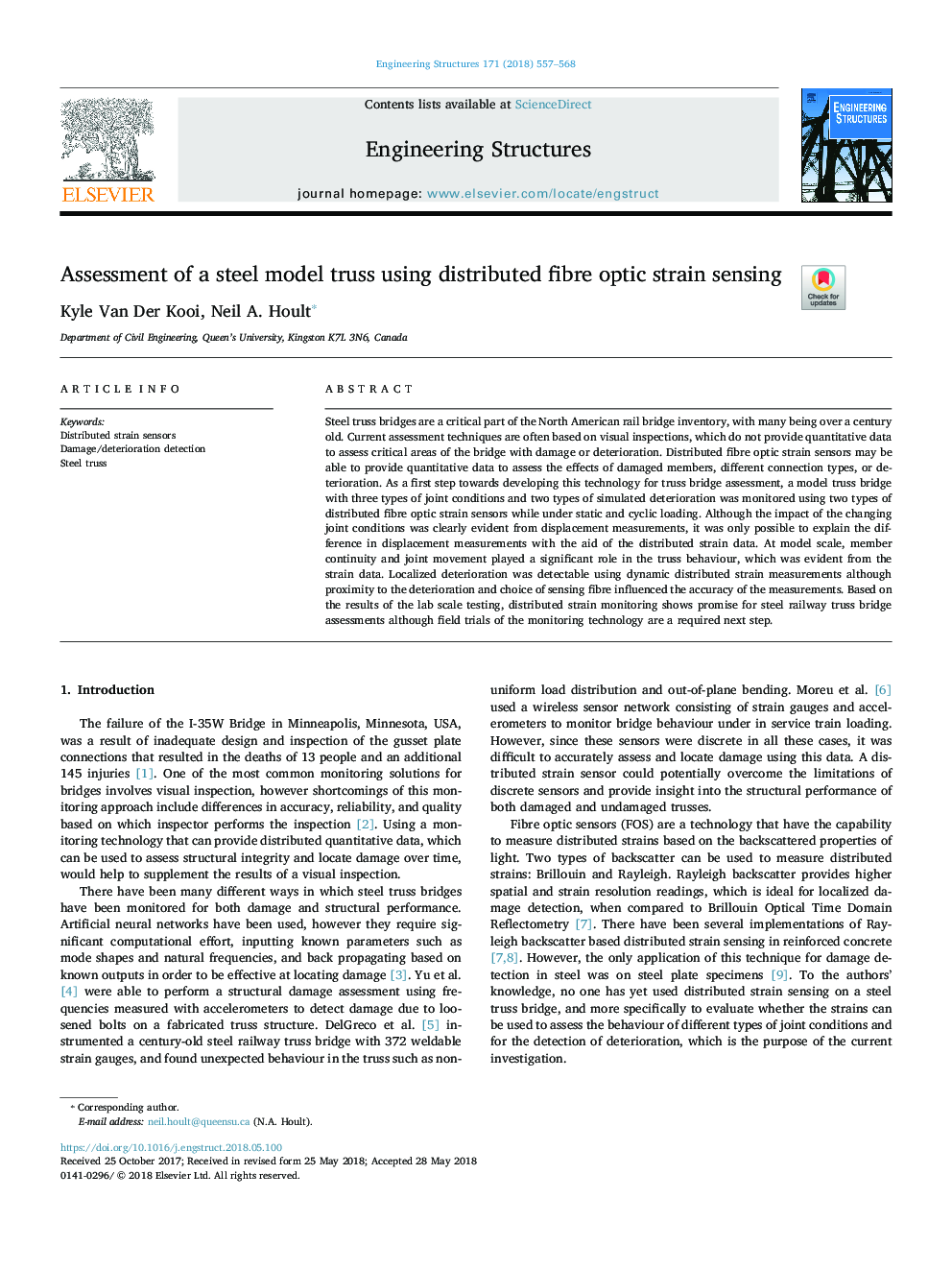| کد مقاله | کد نشریه | سال انتشار | مقاله انگلیسی | نسخه تمام متن |
|---|---|---|---|---|
| 6736371 | 1429056 | 2018 | 12 صفحه PDF | دانلود رایگان |
عنوان انگلیسی مقاله ISI
Assessment of a steel model truss using distributed fibre optic strain sensing
ترجمه فارسی عنوان
ارزیابی مدل تراس مدل فولادی با استفاده از حسگر کشف فیبر نوری توزیع شده
دانلود مقاله + سفارش ترجمه
دانلود مقاله ISI انگلیسی
رایگان برای ایرانیان
کلمات کلیدی
حسگرهای توزیع شده فشار، شناسایی آسیب / خرابکاری، تراس فولادی،
ترجمه چکیده
پل های فولادی فولادی بخش مهمی از فهرست موجودی پل راه آهن آمریکای شمالی است که بسیاری از آنها بیش از یک قرن پیر می شوند. تکنیک های ارزیابی فعلی اغلب بر اساس بازرسی های بصری است که اطلاعات کمی را برای ارزیابی نقاط بحرانی پل با آسیب یا خراب شدن ارائه نمی کنند. سنسورهای توزیع شده فیبر نوری ممکن است قادر به ارائه داده های کمی برای ارزیابی اثرات اعضای آسیب دیده، انواع مختلف اتصال یا خرابی باشند. به عنوان اولین گام در جهت توسعه این تکنولوژی برای ارزیابی پل های تراس، یک مدل تراس پل با سه نوع شرایط مشترک و دو نوع تخریب شبیه سازی شده با استفاده از دو نوع سنسورهای کششی فیبر نوری توزیع شده در حالی که تحت بارگذاری استاتیکی و چرخه ای بود، مورد بررسی قرار گرفت. اگرچه تاثیر تغییر شرایط مشترک از اندازه گیری های جابجایی واضح بود، اما تنها با اندازه گیری داده های جابجایی با کمک داده های توزیع شده می توان توضیح داد. در مقیاس مدل، تداوم عضو و جنبش مشترک نقش مهمی در رفتار تراس ایفا کرد، که از داده های کشف مشهود بود. بدتر شدن وضعیت محلی با استفاده از اندازه گیری های پویا پراکنده توزیع قابل تشخیص بود، اگرچه نزدیکی به بدتر شدن و انتخاب فیبر حساس بر صحت اندازه گیری تأثیر گذاشت. بر اساس نتایج آزمایشی آزمایشگاه، نظارت بر توزیع کششی نشان دهنده وعده ارزیابی خطوط فولادی راه آهن فولادی است، اگرچه آزمایشات میدانی از تکنولوژی مانیتورینگ گامی ضروری است.
موضوعات مرتبط
مهندسی و علوم پایه
علوم زمین و سیارات
مهندسی ژئوتکنیک و زمین شناسی مهندسی
چکیده انگلیسی
Steel truss bridges are a critical part of the North American rail bridge inventory, with many being over a century old. Current assessment techniques are often based on visual inspections, which do not provide quantitative data to assess critical areas of the bridge with damage or deterioration. Distributed fibre optic strain sensors may be able to provide quantitative data to assess the effects of damaged members, different connection types, or deterioration. As a first step towards developing this technology for truss bridge assessment, a model truss bridge with three types of joint conditions and two types of simulated deterioration was monitored using two types of distributed fibre optic strain sensors while under static and cyclic loading. Although the impact of the changing joint conditions was clearly evident from displacement measurements, it was only possible to explain the difference in displacement measurements with the aid of the distributed strain data. At model scale, member continuity and joint movement played a significant role in the truss behaviour, which was evident from the strain data. Localized deterioration was detectable using dynamic distributed strain measurements although proximity to the deterioration and choice of sensing fibre influenced the accuracy of the measurements. Based on the results of the lab scale testing, distributed strain monitoring shows promise for steel railway truss bridge assessments although field trials of the monitoring technology are a required next step.
ناشر
Database: Elsevier - ScienceDirect (ساینس دایرکت)
Journal: Engineering Structures - Volume 171, 15 September 2018, Pages 557-568
Journal: Engineering Structures - Volume 171, 15 September 2018, Pages 557-568
نویسندگان
Kyle Van Der Kooi, Neil A. Hoult,
